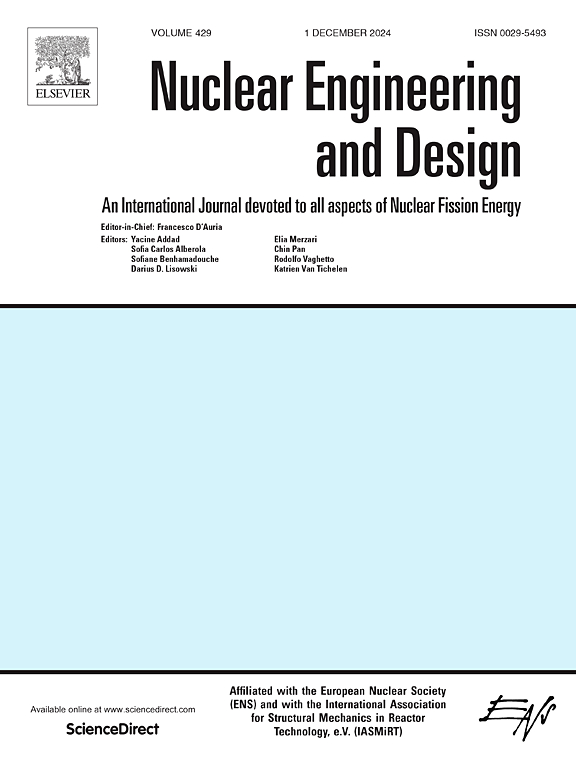乏燃料放射性毒性降低的光核处理:对微量锕系元素的个案研究
IF 2.1
3区 工程技术
Q1 NUCLEAR SCIENCE & TECHNOLOGY
引用次数: 0
摘要
乏燃料的管理是核电站退役的主要挑战之一。热反应堆,如轻水反应堆(LWRs),会产生大量的微量锕系元素(MAs),如镅、Curium和镎,它们是SNF中长期放射性毒性和衰变热的关键因素。目前,长期被广泛接受的解决方案是地质处置。同时,像Partitioning and Transmutation (P&;T)这样的先进技术为降低SNF的长期放射毒性提供了有希望的解决方案。虽然大多数嬗变策略依赖于中子通量,但在本研究中,我们研究了采用光子束在SNF中诱导光子核反应,而不依赖于基于中子的系统。特别是,该研究着重于利用光子核相互作用的巨偶极子共振(GDR)区域,在MAs上诱导嬗变和裂变的概率。在本案例研究中,目的是研究来自SMR技术的乏燃料中存在的少量锕系元素的光子驱动嬗变的影响。重点主要放在研究该系统的物理特性,分析通过该方法降低该系统的库存和放射毒性的可行性,而没有考虑技术方面和局限性。本文章由计算机程序翻译,如有差异,请以英文原文为准。
Photonuclear treatment for spent fuel radiotoxicity reduction: a case study investigation on minor actinides
The management of Spent Nuclear Fuel (SNF) is one of the main challenges in the decommissioning of nuclear power plants. Thermal reactors, such as Light Water Reactors (LWRs), produce significant amounts of minor actinides (MAs) such as Americium, Curium, and Neptunium, which are key contributors to the long-term radiotoxicity and decay heat in SNF. Currently, the long term widely accepted solution is the geological disposal. At the same time, advanced technologies like Partitioning and Transmutation (P&T) offer promising solutions to reduce SNF long-term radiotoxicity. While most transmutation strategies rely on neutron fluxes, in this study the adoption of photon beam to induce photonuclear reactions in SNF is investigated, without depending on neutron based systems. In particular, the study focuses on the probability of inducing transmutations and fissions on MAs, by leveraging the Giant Dipole Resonance (GDR) region of photonuclear interactions. In the presented case study, the aim was to investigate the effect of a photon driven transmutation of minor actinides present in a spent fuel from SMR technology. The focus was mainly put on studying the physics of the system, analysing the feasibility of reducing the inventory and radiotoxicity of the system by this method, without considering technological aspects and limitations.
求助全文
通过发布文献求助,成功后即可免费获取论文全文。
去求助
来源期刊

Nuclear Engineering and Design
工程技术-核科学技术
CiteScore
3.40
自引率
11.80%
发文量
377
审稿时长
5 months
期刊介绍:
Nuclear Engineering and Design covers the wide range of disciplines involved in the engineering, design, safety and construction of nuclear fission reactors. The Editors welcome papers both on applied and innovative aspects and developments in nuclear science and technology.
Fundamentals of Reactor Design include:
• Thermal-Hydraulics and Core Physics
• Safety Analysis, Risk Assessment (PSA)
• Structural and Mechanical Engineering
• Materials Science
• Fuel Behavior and Design
• Structural Plant Design
• Engineering of Reactor Components
• Experiments
Aspects beyond fundamentals of Reactor Design covered:
• Accident Mitigation Measures
• Reactor Control Systems
• Licensing Issues
• Safeguard Engineering
• Economy of Plants
• Reprocessing / Waste Disposal
• Applications of Nuclear Energy
• Maintenance
• Decommissioning
Papers on new reactor ideas and developments (Generation IV reactors) such as inherently safe modular HTRs, High Performance LWRs/HWRs and LMFBs/GFR will be considered; Actinide Burners, Accelerator Driven Systems, Energy Amplifiers and other special designs of power and research reactors and their applications are also encouraged.
 求助内容:
求助内容: 应助结果提醒方式:
应助结果提醒方式:


